Index to Trees & Shrubs in the Order Brassicales
Family: Capparaceae (Caper Family)
122. Boscia albitrunca Shepherd's Tree viewtopic.php?f=248&t=3764#p171504
125. Boscia foetida rehmanniana Bushveld Sheperds Tree, Foetid Shepherds Tree viewtopic.php?p=223744#p223744
131. Cladostemon kirkii Three-Finger Bush, Tonga-Kierie viewtopic.php?p=298454#p298454
133.1 Maerua gilgii River Bush-cherry, River Spider Bush viewtopic.php?f=248&t=3764&p=171506#p171506
136.2 Thilachium africanum Cucumber Bush viewtopic.php?p=533097#p533097
Family: Moringaceae
137. Moringa ovalifolia Phantom Tree, Ghost Tree, African Moringo viewtopic.php?p=189707#p189707
Africa Wild Tree & Shrub Book - Order Brassicales
Moderator: Klipspringer
Re: Africa Wild Tree & Shrub Book - Order Brassicales
122. Shepherd's Tree Boscia albitrunca (Witgat)
Order: Brassicales. Family: Capparaceae
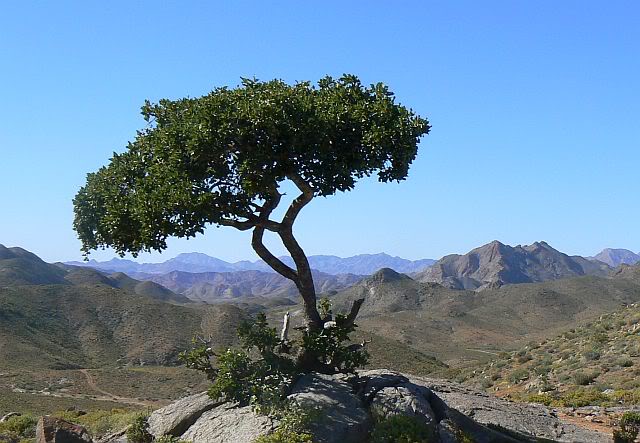
Richtersveld, Hell's kloof
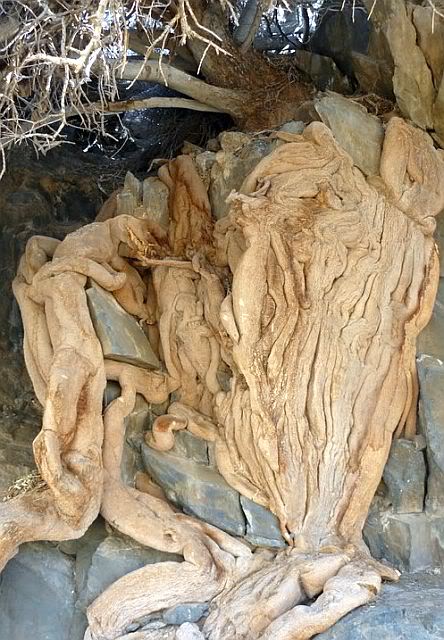
Roots
Description
It is a small to medium-sized evergreen tree up to 7 m tall. It has a dense, round to spreading crown. It can be a single-stemmed, relatively high-branching tree with a crooked or twisted stem (up to 8 m). Over much of the Kalahari and the Karoo, it is a small rounded shrub.
The conspicuous, whitish bark can make the tree look as if it has been whitewashed. It is often pitted and folded, and may have tiny holes. In some areas older bark becomes yellowish or blackish, and can be flaky.
The leathery leaves are arranged in clusters in bunches of 4 - 5 on both older branches and on short, spiky side-branchlets. On new growth they may be scattered alternately. They have smooth margins and a short leaf-stalk (Leaf variable, usually 20 - 60 x 4 - 20 mm).
The flowers are borne in clusters on short shoots. They are small, sweet-scented, greenish-yellow and are usually on older growth. They occur singly, or in small, dense clusters, on short side-branchlets usually on older wood. Flowering trees have a striking yellow-green tinge. The flowers appear from July to November, but generally start in August, depending on rainfall (4 mm diam.)
Fruit grows in bunches along the fruit-stalk (Oct - Mar) (10 mm diam.).
Habitat
It is found in the drier parts of southern Africa, in areas of low rainfall.
Distribution
Botswana, South Africa (Limpopo, Gauteng, North-West, Free State, Northern Cape and KwaZulu-Natal), Swaziland. It also extends into Zambia, Zimbabwe and Mozambique.
Links: Rina Grant, Val Thomas: Sappi Tree Spotting: Highlands: Highveld, Drakensberg, Eastern Cape Mountains
Order: Brassicales. Family: Capparaceae

Richtersveld, Hell's kloof

Roots
Description
It is a small to medium-sized evergreen tree up to 7 m tall. It has a dense, round to spreading crown. It can be a single-stemmed, relatively high-branching tree with a crooked or twisted stem (up to 8 m). Over much of the Kalahari and the Karoo, it is a small rounded shrub.
The conspicuous, whitish bark can make the tree look as if it has been whitewashed. It is often pitted and folded, and may have tiny holes. In some areas older bark becomes yellowish or blackish, and can be flaky.
The leathery leaves are arranged in clusters in bunches of 4 - 5 on both older branches and on short, spiky side-branchlets. On new growth they may be scattered alternately. They have smooth margins and a short leaf-stalk (Leaf variable, usually 20 - 60 x 4 - 20 mm).
The flowers are borne in clusters on short shoots. They are small, sweet-scented, greenish-yellow and are usually on older growth. They occur singly, or in small, dense clusters, on short side-branchlets usually on older wood. Flowering trees have a striking yellow-green tinge. The flowers appear from July to November, but generally start in August, depending on rainfall (4 mm diam.)
Fruit grows in bunches along the fruit-stalk (Oct - Mar) (10 mm diam.).
Habitat
It is found in the drier parts of southern Africa, in areas of low rainfall.
Distribution
Botswana, South Africa (Limpopo, Gauteng, North-West, Free State, Northern Cape and KwaZulu-Natal), Swaziland. It also extends into Zambia, Zimbabwe and Mozambique.
Links: Rina Grant, Val Thomas: Sappi Tree Spotting: Highlands: Highveld, Drakensberg, Eastern Cape Mountains
Re: Africa Wild Tree & Shrub Book - Order Brassicales
133.1 River Bush-cherry, River Spider Bush Maerua gilgii (Rivierwitbos)
Order: Brassicales. Family: Capparaceae


Augrabies Falls National Park
Description
Evergreen tree or large woody shrub up to 3 m high, multi-stemmed, with olive-yellow to green twigs. Branches slender, often drooping. Bark grey.
Leaves simple, sessile, olive-yellow to green, spirally arranged. Inflorescence consisting of 6-9-flowered racemes (petals absent).
Distribution
Namibia and South Africa (Northern Cape) along the Orange River, Bushmanland, southern Namib.
Habitat
Dry rocky river valley, on river banks and floodplains.
Order: Brassicales. Family: Capparaceae


Augrabies Falls National Park
Description
Evergreen tree or large woody shrub up to 3 m high, multi-stemmed, with olive-yellow to green twigs. Branches slender, often drooping. Bark grey.
Leaves simple, sessile, olive-yellow to green, spirally arranged. Inflorescence consisting of 6-9-flowered racemes (petals absent).
Distribution
Namibia and South Africa (Northern Cape) along the Orange River, Bushmanland, southern Namib.
Habitat
Dry rocky river valley, on river banks and floodplains.
Re: Africa Wild Tree & Shrub Book - Order Brassicales
137. Phantom Tree, Ghost Tree, Fairy-tale Tree, African Moringo Moringa ovalifolia (Sprokiesboom, Meelsakboom)
Order: Brassicales. Family: Moringaceae
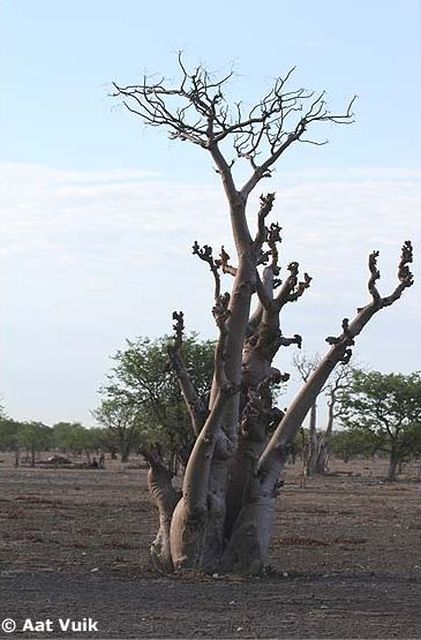 © aat
© aat
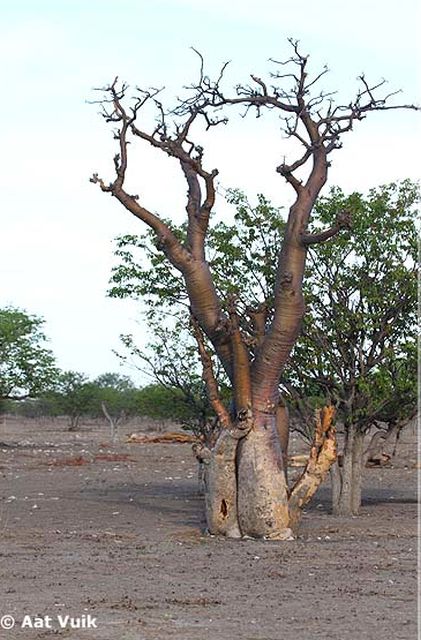 © aat
© aat
Etosha National Park, Namibia
Description
A conspicuous, erect, deciduous tree up to 7 m high, bearing a succulent, often bottle-shaped main branch up to 1 m in diameter. The roots are fleshy. The bark is smooth, brown to silvery copper, with a shiny green sheen, and resinous. The leaves (tending to droop) are alternately arranged, twice-compound and up to 0.6 m long with up to 4 pairs of pinna, each with up to 7 pairs of opposite, oval leaflets and a terminal leaflet. The leaflets can grow up to 25 mm long.
The white flowers are borne in branched axillary sprays (panicles), each up to 3 mm in diameter with 4-5 petals. They are followed by grey-brown, three-angled pods, up to 400 mm long, which split along three valves, releasing the winged seeds. Flowering time: mainly November to May (fruiting October to May).
Distribution
Indigenous to Namibia and Angola. Widely distributed in Namibia from the escarpment mountains northwest of Keetmanshoop to the Kaokoveld in the north, and further north into Angola.
Habitat
Its habitat consists mainly of desert or arid savannah vegetation. In the north it grows in dry mopane woodland (Colophospermum mopane). At Epupa Falls, beautiful examples occur on the rocky island and can be seen growing together with the baobab (Adansonia digitata), Commiphora virgata, Euphorbia subsalsa, Adenium oleifolium and Pachypodium lealii. The soil is sandy, rich in gravel and may be alkaline, neutral to slightly acid. The trees usually only grow on the slopes of mountains and hills and Etosha is the only place where the trees grow in such numbers on the plains.
Links: Braam Van Wyk, Piet Van Wyk: Field Guide to Trees of Southern Africa
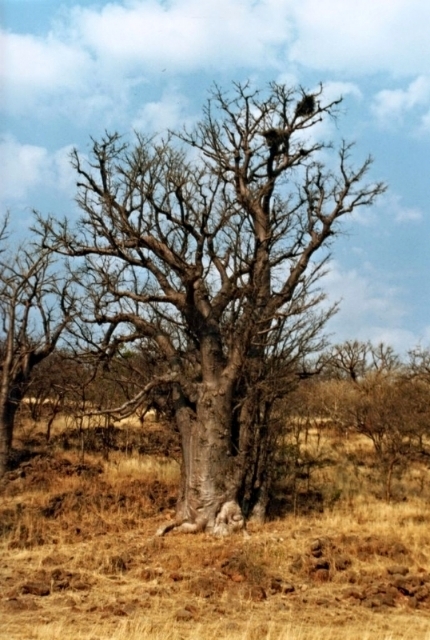 © Toko
© Toko
Kaokoveld, Namibia
Order: Brassicales. Family: Moringaceae
 © aat
© aat © aat
© aatEtosha National Park, Namibia
Description
A conspicuous, erect, deciduous tree up to 7 m high, bearing a succulent, often bottle-shaped main branch up to 1 m in diameter. The roots are fleshy. The bark is smooth, brown to silvery copper, with a shiny green sheen, and resinous. The leaves (tending to droop) are alternately arranged, twice-compound and up to 0.6 m long with up to 4 pairs of pinna, each with up to 7 pairs of opposite, oval leaflets and a terminal leaflet. The leaflets can grow up to 25 mm long.
The white flowers are borne in branched axillary sprays (panicles), each up to 3 mm in diameter with 4-5 petals. They are followed by grey-brown, three-angled pods, up to 400 mm long, which split along three valves, releasing the winged seeds. Flowering time: mainly November to May (fruiting October to May).
Distribution
Indigenous to Namibia and Angola. Widely distributed in Namibia from the escarpment mountains northwest of Keetmanshoop to the Kaokoveld in the north, and further north into Angola.
Habitat
Its habitat consists mainly of desert or arid savannah vegetation. In the north it grows in dry mopane woodland (Colophospermum mopane). At Epupa Falls, beautiful examples occur on the rocky island and can be seen growing together with the baobab (Adansonia digitata), Commiphora virgata, Euphorbia subsalsa, Adenium oleifolium and Pachypodium lealii. The soil is sandy, rich in gravel and may be alkaline, neutral to slightly acid. The trees usually only grow on the slopes of mountains and hills and Etosha is the only place where the trees grow in such numbers on the plains.
Links: Braam Van Wyk, Piet Van Wyk: Field Guide to Trees of Southern Africa
 © Toko
© TokoKaokoveld, Namibia
Re: Africa Wild Tree & Shrub Book - Order Brassicales
125. Bushveld Sheperds Tree, Foetid Shepherds Tree, Stink Shepherds Tree Boscia foetida rehmanniana (Fynblaar-Witgat, Stinkwitgat)
Order: Brassicales. Family: Capparaceae


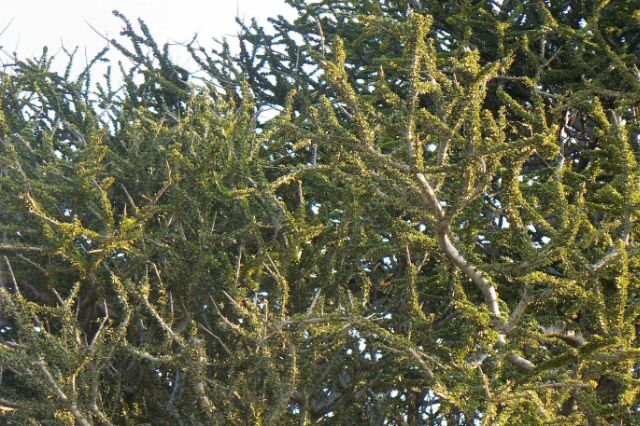
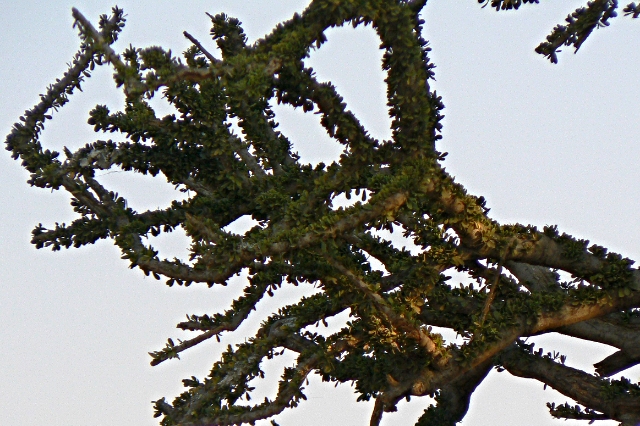
Pilanesberg
Description
Small tree to 4 m. Main stem starting to branch 1 m above ground. Leaves smaller than in B. albitrunca, hairless. Bark pale brown or grey; branches often spine tipped. Leaves in tight clusters on small angled spurs along the branches, oblanceolate to obovate, normally less than 1.3 cm long, grey-green. Flowers in small clusters, small, without petals, greenish with a strong unpleasant scent. Fruit round, c. 10 mm in diameter, velvety, yellowish when ripe.
Habitat
Occurring in hot and very dry open bushveld, usually on clay soils, often on termite mounds.
Distribution
Botswana, Zimbabwe and the drier parts of northern South Africa (Gauteng, Limpopo, Mpumalanga, North West).
Links: Trees and Shrubs of Mpumalanga and Kruger National Park
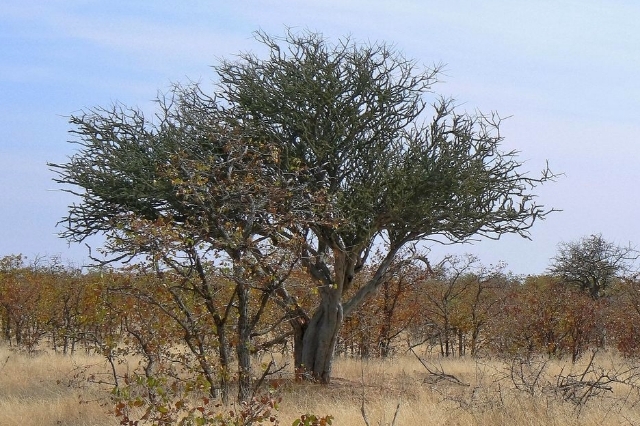
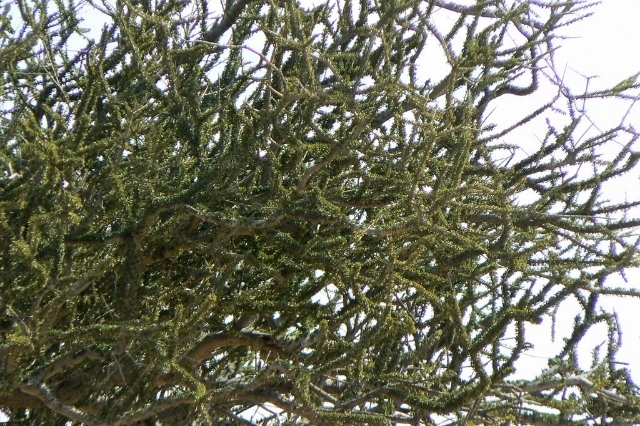
Mapungubwe National Park, Limpopo
Order: Brassicales. Family: Capparaceae




Pilanesberg
Description
Small tree to 4 m. Main stem starting to branch 1 m above ground. Leaves smaller than in B. albitrunca, hairless. Bark pale brown or grey; branches often spine tipped. Leaves in tight clusters on small angled spurs along the branches, oblanceolate to obovate, normally less than 1.3 cm long, grey-green. Flowers in small clusters, small, without petals, greenish with a strong unpleasant scent. Fruit round, c. 10 mm in diameter, velvety, yellowish when ripe.
Habitat
Occurring in hot and very dry open bushveld, usually on clay soils, often on termite mounds.
Distribution
Botswana, Zimbabwe and the drier parts of northern South Africa (Gauteng, Limpopo, Mpumalanga, North West).
Links: Trees and Shrubs of Mpumalanga and Kruger National Park


Mapungubwe National Park, Limpopo
Re: Africa Wild Tree & Shrub Book - Order Brassicales
131. Three-Finger Bush, Tonga-Kierie Cladostemon kirkii (Drievingerbos )
Order: Brassicales. Family: Capparaceae
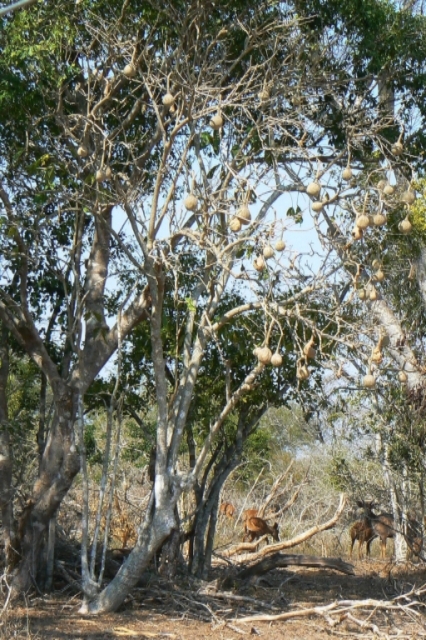
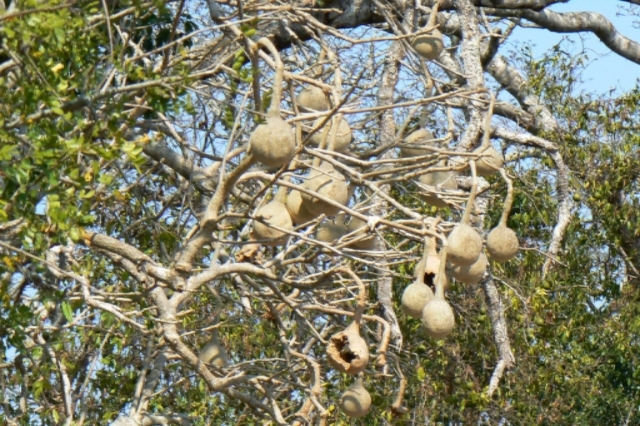
Tembe Elephant Park
Description
A deciduous tree up to 6 m tall. The bark is yellowish and grey, rough, adhering, marked by narrow fissures forming thin scales. The leaves arise singly at each node, and each has three leaflets; the common petiole is 50-200 mm long. The blade of each leaflet is 40-150 x 20-70 mm, ovate to elliptical, widest above or below the middle, with narrow tips and bases, and the surface is hairy below.
Flowers are borne in spikes at or near the tips of branches. There are 4 free, narrowly ovate sepals which are much smaller than the petals, 15-30 x 1.5-5 mm. There are 4 free, ovate petals, white with pink veins; a large pair 35-45 x 25-35 mm, and a smaller pair15--30 x 1.5--5 mm. The common stalk bearing the stamens and ovary is 90-130 mm long.
The pendulous fruit is fleshy, buff-brown and evil-smelling even when young; 170-220 x 70-120 mm, gourd-shaped. The seeds are mid-brown, 8-13 mm long and wide.
Habitat
In bushveld, sand forest, open woodland and scrub in hot areas, often on sandy soils.
Distribution
It occurs in southern DR Congo and southern Kenya and from there southward to northern South Africa (KZN) and Swaziland.
Links: Field Guide to Trees of Southern Africa
Order: Brassicales. Family: Capparaceae


Tembe Elephant Park
Description
A deciduous tree up to 6 m tall. The bark is yellowish and grey, rough, adhering, marked by narrow fissures forming thin scales. The leaves arise singly at each node, and each has three leaflets; the common petiole is 50-200 mm long. The blade of each leaflet is 40-150 x 20-70 mm, ovate to elliptical, widest above or below the middle, with narrow tips and bases, and the surface is hairy below.
Flowers are borne in spikes at or near the tips of branches. There are 4 free, narrowly ovate sepals which are much smaller than the petals, 15-30 x 1.5-5 mm. There are 4 free, ovate petals, white with pink veins; a large pair 35-45 x 25-35 mm, and a smaller pair15--30 x 1.5--5 mm. The common stalk bearing the stamens and ovary is 90-130 mm long.
The pendulous fruit is fleshy, buff-brown and evil-smelling even when young; 170-220 x 70-120 mm, gourd-shaped. The seeds are mid-brown, 8-13 mm long and wide.
Habitat
In bushveld, sand forest, open woodland and scrub in hot areas, often on sandy soils.
Distribution
It occurs in southern DR Congo and southern Kenya and from there southward to northern South Africa (KZN) and Swaziland.
Links: Field Guide to Trees of Southern Africa
-
Klipspringer
- Global Moderator
- Posts: 5858
- Joined: Sat Sep 14, 2013 12:34 pm
- Country: Germany
- Contact:
Re: Africa Wild Tree & Shrub Book - Order Brassicales
136.2 Cucumber Bush Thilachium africanum
Order Brassicales. Family Capparaceae
Kruger National Park, Shingwedzi area in early November 2014 © arks
Description
Rounded woody shrub or small tree, 1-4 m. Main stem greyish-brown; branches covered with lenticels; young branch tips rough.
Leaves alternate, compound, 3-foliate, occasionally simple; elliptic to obovate (30-90 x 1045 mm); apex tapering to rounded, bristle-tipped; margin entire, rolled under; dark green; hairless, leathery; leaflet petiolules 2-4 mm long; petiole scabrid, to 60 mm long.
Flowers large, white; calyx splitting in half horizontally with the cap attached on one side (Aug to Oct).
Fruit cucumber-like with approximately 12 longitudinal ridges, to 60 mm long (Oct to Dec).
Distribution
From northern KwaZulu-Natal, through eSwatini, Mozambique, Mpumalanga and the Limpopo Province, into East Africa.
Habitat
Arid bushveld and thickets
Ecology
Bees and butterflies visit during the flowering season. Ants are also observed exploring the fruits. Monkeys eat the fruits and the leaves are heavily browsed.
Links:
http://pza.sanbi.org/thilachium-africanum
https://www.zimbabweflora.co.zw/species ... _id=124710
Order Brassicales. Family Capparaceae
Kruger National Park, Shingwedzi area in early November 2014 © arks
Description
Rounded woody shrub or small tree, 1-4 m. Main stem greyish-brown; branches covered with lenticels; young branch tips rough.
Leaves alternate, compound, 3-foliate, occasionally simple; elliptic to obovate (30-90 x 1045 mm); apex tapering to rounded, bristle-tipped; margin entire, rolled under; dark green; hairless, leathery; leaflet petiolules 2-4 mm long; petiole scabrid, to 60 mm long.
Flowers large, white; calyx splitting in half horizontally with the cap attached on one side (Aug to Oct).
Fruit cucumber-like with approximately 12 longitudinal ridges, to 60 mm long (Oct to Dec).
Distribution
From northern KwaZulu-Natal, through eSwatini, Mozambique, Mpumalanga and the Limpopo Province, into East Africa.
Habitat
Arid bushveld and thickets
Ecology
Bees and butterflies visit during the flowering season. Ants are also observed exploring the fruits. Monkeys eat the fruits and the leaves are heavily browsed.
Links:
http://pza.sanbi.org/thilachium-africanum
https://www.zimbabweflora.co.zw/species ... _id=124710


